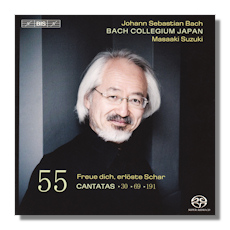
The Internet's Premier Classical Music Source
Related Links
- Bach Reviews
- Latest Reviews
- More Reviews
-
By Composer
-
Collections
DVD & Blu-ray
Books
Concert Reviews
Articles/Interviews
Software
Audio
Search Amazon
Recommended Links
Site News
 CD Review
CD Review
Johann Sebastian Bach

Cantatas Volume 55
From Leipzig 1730s-40s
- Lobe den Herrn, meine Seele, BWV 69
- Freue dich, erlöste Schar, BWV 30
- Gloria in excelsis Deo, BWV 191
Hana Blažïková, soprano
Robin Blaze, countertenor
Gerd Türk, tenor
Peter Kooij, bass
Bach Collegium Japan/Masaaki Suzuki
BIS SACD-2031
It's rather sad to see the sticker advising us that this, Volume 55, is the last in Masaaki Suzuki's epic series from BIS of the entire cycle of Bach cantatas. Begun 18 years ago, it has taken longer than either of the other two and comparable now complete cycles – that by Ton Koopman on Challenge and by John Eliot Gardiner on SDG.
Although the differences between these three sets are not so stark as perhaps one might have expected when they began and as each conductor developed his own style in the project, it's safe to say that Gardiner tends more to the bright, the dramatic and the demonstrative than Koopman or Suzuki. Though he is never brash or over-colored. Koopman, who also uses modern instruments, is as spare in allocation of voices to a part as is Gardiner. Koopman falls midway between the SDG and BIS sets in terms of extroversion and reflection.
This CD, Suzuki's last, then, contains three cantatas from later in Bach's life: Lobe den Herrn, BWV 69, was probably first performed in 1748 to mark a change in local government. Freue dich, BWV 30 is a late (1738?) church cantata for the Feast Day of St. John the Baptist while Gloria in excelsis Deo BWV 191 is a Christmas composition. Material from BWV 191 was also used in the (Gloria of) the B minor Mass. In each case Suzuki holds a superb balance between soloists (most are the same as those used throughout the cycle) and chorus; as well as between solo and ensemble instruments.
Yet there is a certain relaxed, almost celebratory, quality to Peter Kooij's bass in movements like the aria, "Gelobet sei Gott" [tr.9] of Freue dich. As is that of the other solists, its delivery is forthright, keen, sensitive and fully ensconced in the immediacy of spirit exhibited in Bach's long lines and developing narrative. If it's remembered that the texts are the starting points for these compositions, such an approach makes perfect sense. The singers expose, offer and extend without declaiming.
Similarly, in the moments where solo instruments shine – the flute in the Gloria's duet [tr.20] for instance – we hear the joy and pleasure that emanate from first class playing in the service of sublime music. But we hear it in the context of a work conceived as a whole. Forward movement, but thoughtful movement, is always at a premium. The ensemble playing of the Bach Collegium Japan (BCJ) is just as good.
Suzuki, then, has developed a mature and persuasive conception of Bach's achievement. And its place in the wider (Baroque) repertoire. This is exhibited not least in an awareness of the architecture of each cantata, movement and even each phrase. Although, inevitably, there is a sequential aspect: the one follows the other. All the components of this wonderful music, the allusions, references, quotations and developments are part of a wonderful whole. Suzuki's pacing and construction of textures pays this due honor.
The acoustic – the Kobe Shoin Women's University Chapel in Japan – is the same as that used for all these recordings on BIS. Earlier releases were not all on SACD. This one is though; and the sound is superb. It's full, resonant and reflects the blend which Suzuki has aimed for (and achieved) between the splendor of this repertoire with its original celebratory purposes, and its function as music to concentrate congregants' worship. At the same time Suzuki pulls out the intimacy and reflection necessary for that marriage between words and music. The closing chorus of Freue dich [tr.18] is a good example.
As well as the full text in German and English, the booklet describes the three works, supplies brief biographies of the performers; and a personal reflection by the Suzuki on what the cycle and his involvement with the BCJ in its performance have meant to him. Modestly, the conductor makes no mention of just how great his (their) achievement is. But we should make no mistake. This volume is but one of 55 exhibiting consistently high standards of conception and execution. No lover of Bach (or indeed of Baroque vocal music) will want to be without at least some familiarity with this cycle.
Copyright © 2014, Mark Sealey





















